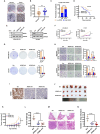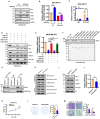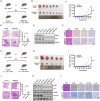NONO interacts with nuclear PKM2 and directs histone H3 phosphorylation to promote triple-negative breast cancer metastasis
- PMID: 40059196
- PMCID: PMC11892261
- DOI: 10.1186/s13046-025-03343-5
NONO interacts with nuclear PKM2 and directs histone H3 phosphorylation to promote triple-negative breast cancer metastasis
Abstract
Background: Emerging evidence has revealed that PKM2 has oncogenic functions independent of its canonical pyruvate kinase activity, serving as a protein kinase that regulates gene expression. However, the mechanism by which PKM2, as a histone kinase, regulates the transcription of genes involved in triple-negative breast cancer (TNBC) metastasis remains poorly understood.
Methods: We integrated cellular analysis, including cell viability, proliferation, colony formation, and migration assays; biochemical assays, including protein interaction studies and ChIP; clinical sample analysis; RNA-Seq and CUT&Tag data; and xenograft or mammary-specific gene knockout mouse models, to investigate the epigenetic modulation of TNBC metastasis via NONO-dependent interactions with nuclear PKM2.
Results: We report that the transcription factor NONO directly interacts with nuclear PKM2 and directs PKM2-mediated phosphorylation of histone H3 at threonine 11 (H3T11ph) to promote TNBC metastasis. We show that H3T11ph cooperates with TIP60-mediated acetylation of histone H3 at lysine 27 (H3K27ac) to activate SERPINE1 expression and to increase the proliferative, migratory, and invasive abilities of TNBC cells in a NONO-dependent manner. Conditional mammary loss of NONO or PKM2 markedly suppressed SERPINE1 expression and attenuated the malignant progression of spontaneous mammary tumors in mice. Importantly, elevated expression of NONO or PKM2 in TNBC patients is positively correlated with SERPINE1 expression, enhanced invasiveness, and poor clinical outcomes.
Conclusion: These findings revealed that the NONO-dependent interaction with nuclear PKM2 is key for the epigenetic modulation of TNBC metastasis, suggesting a novel intervention strategy for treating TNBC.
Keywords: Epigenomics; H3T11ph; Metastasis; NONO; PKM2; Transcription; Triple-negative breast cancer.
© 2025. The Author(s).
Conflict of interest statement
Declarations. Ethics approval and consent to participate: All experiments involving animals were conducted according to the ethical policies and procedures approved by the Animal Ethical and Welfare Committee of Nanjing University (Nanjing, China) under protocol IACUC-2112006. Consent for publication: Not applicable. Competing interests: The authors declare no competing interests.
Figures








References
-
- Bray F, Laversanne M, Sung HYA, Ferlay J, Siegel RL, Soerjomataram I, Jemal A. Global cancer statistics 2022: GLOBOCAN estimates of incidence and mortality worldwide for 36 cancers in 185 countries. CA Cancer J Clin. 2024;74:229–63. - PubMed
-
- Gluz O, Liedtke C, Gottschalk N, Pusztai L, Nitz U, Harbeck N. Triple-negative breast cancer–current status and future directions. Ann Oncol. 2009;20:1913–27. - PubMed
-
- Dent R, Trudeau M, Pritchard KI, Hanna WM, Kahn HK, Sawka CA, Lickley LA, Rawlinson E, Sun P, Narod SA. Triple-negative breast cancer: clinical features and patterns of recurrence. Clin Cancer Res. 2007;13:4429–34. - PubMed
MeSH terms
Substances
Grants and funding
- 2021byzd141/Natural Science Foundation of Bengbu Medical College
- 2023AH051989/Key Project of Natural Science Research for the University of Anhui Province
- 32270619/National Natural Science Foundation of China
- LNSN-202403/Fundamental Research Fund of the State Key Laboratory of Pharmaceutical Biotechnology
LinkOut - more resources
Full Text Sources
Miscellaneous

